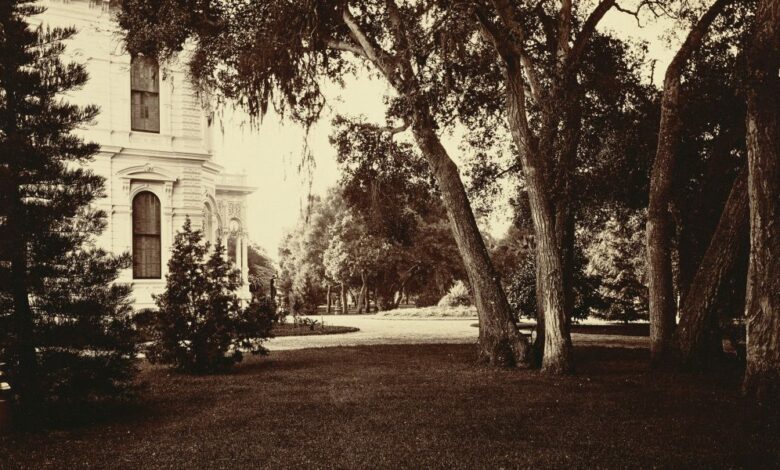Neighbors in a wealthy Bay Area enclave created a ‘heritage alliance’ to become a historic district—and it all started with one home and a new family


Gene Alston bought a home on Fairfax Avenue in Baywood, a small neighborhood in San Mateo, California, three years ago. His family moved in a couple months later, but the house had more issues than he was aware of, and after discussing with his architect, Alston decided it made more sense to tear it down and rebuild rather than remodel. The plan was to build a larger home in its place with an accessory dwelling unit for his mother-in-law. Alston learned that among other things, a historic review was required; to his relief, it turned out that the property was not considered historical.
But later that year, the enmity began.
Some in the neighborhood appeared unhappy. Emails and flyers went around, Alston said. It was multifaceted. Some people didn’t agree with the finding that his home wasn’t historical, while others didn’t think his family should have an accessory dwelling unit (or ADU). Some objected to the proposed design or style of the Alston family home. It didn’t matter that he’d just paid about $2.8 million for his home in the neighborhood, per an estimate, and he owns it. Members of the newly formed San Mateo Heritage Alliance and the Baywood Neighborhood Association, whose president is Michael Nash, husband of San Mateo Mayor Lisa Diaz Nash, were among the opposition, Alston said. (Michael Nash is a former San Mateo Heritage Alliance Board member, and Mayor Lisa Diaz Nash is listed as a vice president on the Baywood Neighborhood Association board, however she has recused herself on all things related to the matter.)
After several meetings and phone calls, multiple applications, thousands of dollars, and anonymous complaints, Alston’s plan was approved in 2022 and demolition began last year. But that hasn’t stopped his neighbors. The San Mateo Heritage Alliance, which seems to be an opulent homeowners’ clique, was founded in 2022. Toward the end of last year, it filed an application to the State Historical Resources Commission to turn their neighborhood into a historic district, which would make remodeling and building in the neighborhood much more difficult, time consuming, and costly, at the very least.
More recently, in late February, the San Mateo County Board of Supervisors had a chance to weigh in on the matter and ultimately opted out—although it was always completely in the hands of the Office of Historic Preservation.
Alston doesn’t want to definitively say there’s a racial factor, but as someone who is Black and Korean, he’s begun to wonder why some of his neighbors are going to such lengths, when there were other demolitions, when his home wasn’t deemed historic, when other homes have floor- area ratios that exceed his. “You kind of have to ask, well, what went into them saying this house was the one that they should oppose?” Alston said.
‘A Sham’
Baywood is lined with beautiful, pre-war style homes. It sits in Silicon Valley’s backyard and is unsurprisingly an affluent neighborhood in the Bay Area, with home values ranging anywhere from $2 million to $5 million dollars. It’s not the first affluent neighborhood in California, let alone the Bay Area, to oppose change in their predominantly single-family-home towns, and it won’t be the last. There are several pieces of recent and past legislation in California meant to streamline and spur development in hopes of mending a severe housing crisis. In some cases, they are weaponized by wealthy, resourceful homeowners to block new housing from being built. What Baywood is doing is no different, and it seems to have all begun with one new home , and maybe the fear that more change, and more development, would follow. There are carve outs for historic preservation sometimes, and the neighborhood is using that to their benefit.
“It’s a sham,” Jordan Grimes, a San Francisco Peninsula housing advocate who was born and raised in San Mateo, said. “It is a pretty nakedly transparent effort at this point, and an exploitation of this exemption in state housing laws for true historic preservation, in an attempt to prevent new housing growth in one of San Mateo’s most exclusive and exclusionary neighborhoods.”
On the San Mateo Heritage Alliance’s website, under its frequently asked questions section about turning Baywood into a historic district, there’s no explicit mention of the housing law (or laws) it’s hoping to skirt. Although we can assume it is referring to SB 9 (a senate bill that made it possible to build up to four homes where only a single-family home once was) when it says, “your next door neighbor can at their discretion, without your knowledge, demolish their historic home and erect a 4-unit apartment building next to you.”
Nevertheless, the San Mateo Heritage Alliance went on to claim that a historic district designation would protect property rights and equate to higher property values—this time, explicitly mentioning multifamily development. “Without designation, new state housing laws will do away with routine city review and your right to express your views or comment on multifamily construction in your single family neighborhood,” the website reads.
In an opinion piece for the San Mateo Daily Journal titled, “Making a case for historic districts,” the San Mateo Heritage Alliance’s president Laurie Hietter wrote that Baywood hasn’t changed much over the last century. She and her husband bought their home in the ‘90s, she wrote, and “carefully renovated it without affecting its historic character.” So renovation was acceptable in this case, it seems. But it’s “the continual unnecessary loss of beautiful homes” driving her support of Baywood becoming a historic district, Hietter wrote.
“This is not about historic preservation for them, it’s about stopping what they believe to be incompatible development, or multifamily development—that we know is more likely to be inhabited by people who have lower incomes and people of color,” Grimes said.
The San Mateo Heritage Alliance did not respond to Fortune’s request for comment. Michael Nash of the Baywood Neighborhood Association said it “is not taking a position on this issue. Our members have asked us for information to educate them on the topic. We are providing that in cooperation with the City.”
Mayor Lisa Diaz Nash did not respond to a request for comment.
A spokesperson for San Mateo, in regards to a supposed partnership, said it “engages actively with all neighborhood associations, to inform them of important citywide updates that impact their communities and gain feedback from them on potential City-driven initiatives to ensure their community’s voices are heard.”
‘Not part of the in crowd’
When wealthier neighborhoods request historic designation, it seems as if they’re doing so to protect the status quo, Sheri Bonstelle, a partner at Jeffer Mangels and land-use attorney, said. “I love historic preservation,” she said, “but it’s not necessary, typically, to protect beautiful homes and wealthy suburbs.”
What’s particularly off-putting is that California has a housing crisis and everyone knows it; the state needs more homes, it’s as simple as that. And after decades of failed policy that fueled an inability and refusal to build, the waves of legislation that have been passed in recent years to allow development in predominantly single-family home neighborhoods haven’t solved the problem. Part of it is because of highly intelligent, rich homeowners; they’re against change, whether that be the addition of multifamily development in their neighborhood or something else. Sometimes it’s the rich and famous, from Steph Curry to Marc Andreessen, against multifamily development, in their case, in Atherton (the most expensive zip code in the country). Or maybe a wealthy, small beach town that doesn’t want a rail project that connects San Diego to the rest of the country beneath their homes. Maybe it’s all of San Francisco, and its local control and discretionary process that affluent not-in-my-backyard residents use to stop housing from being built, as the state put it in a first-of-its kind report, labeling the city as ground-zero for its housing crisis. It may be a fear of change, or something more.
“We’re not doing anything that’s extreme,” Alston said. He was looking forward to living in this neighborhood and was really shocked at what happened. Whatever motivation there is behind the resistance to his home, that seemed to set this all in motion, and led to their applying for historic designation, “it disadvantages people that are not part of the in-crowd or the neighborhood,” Alston said. “You can kind of draw your own conclusions on what that means.”
Before the Fair Housing Act, Baywood had housing covenants that made it illegal for people of color to buy a home in the neighborhood. “When you have people who are saying we want to preserve this heritage, there’s sort of a question of, what is it you’re really looking to preserve? And if we’re going to be talking about history, we should talk about all of it and whether or not that is worth preserving,” Grimes said.
Source link




